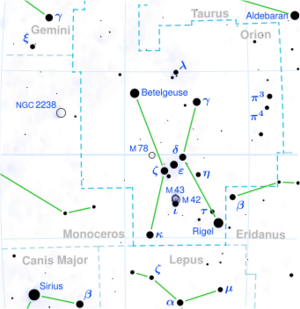Astronomy:Ross 47
From HandWiki
Short description: Star in the constellation Orion
Coordinates: ![]() 05h 42m 09.26772s, +12° 29′ 21.6225″
05h 42m 09.26772s, +12° 29′ 21.6225″
| Observation data Equinox J2000.0]] (ICRS) | |
|---|---|
| Constellation | Orion |
| Right ascension | 05h 42m 09.26769s[1] |
| Declination | +12° 29′ 21.6048″[1] |
| Apparent magnitude (V) | +11.48 - 11.55[2] |
| Characteristics | |
| Evolutionary stage | red dwarf |
| Spectral type | M4V[3] |
| U−B color index | +14.264 |
| B−V color index | +13.130 |
| Variable type | BY Dra[2] |
| Astrometry | |
| Radial velocity (Rv) | 106.06±0.18[1] km/s |
| Proper motion (μ) | RA: +1,997.342[1] mas/yr Dec.: −1569.63[1] mas/yr |
| Parallax (π) | 172.6762 ± 0.0286[1] mas |
| Distance | 18.888 ± 0.003 ly (5.7912 ± 0.0010 pc) |
| Absolute magnitude (MV) | +12.73[4] |
| Details | |
| Mass | 0.218±0.005[5] M☉ |
| Radius | 0.238±0.009[5] R☉ |
| Luminosity | 0.006288±0.000094[5] L☉ |
| Surface gravity (log g) | 4.44[1] cgs |
| Temperature | 3,334+67 −63[5] K |
| Metallicity [Fe/H] | −0.19±0.17[6] dex |
| Rotation | 170[7] |
| Rotational velocity (v sin i) | 3.1[8] km/s |
| Age | 7.1[9] Gyr |
| Other designations | |
| Database references | |
| SIMBAD | data |
Location of Ross 47 in the constellation Orion | |
Ross 47 is a variable star of spectral type M4 located in the constellation Orion, 19 light-years from Earth.
References
- ↑ 1.0 1.1 1.2 1.3 1.4 1.5 1.6 Vallenari, A. et al. (2022). "Gaia Data Release 3. Summary of the content and survey properties". Astronomy & Astrophysics. doi:10.1051/0004-6361/202243940 Gaia DR3 record for this source at VizieR.
- ↑ 2.0 2.1 Samus, N. N. et al. (2017). "General Catalogue of Variable Stars". Astronomy Reports. GCVS 5.1 61 (1): 80–88. doi:10.1134/S1063772917010085. Bibcode: 2017ARep...61...80S.
- ↑ Kirkpatrick, J. Davy; Henry, Todd J.; McCarthy, Donald W. Jr. (1991). "A standard stellar spectral sequence in the red/near-infrared - Classes K5 to M9". Astrophysical Journal Supplement 77: 417. doi:10.1086/191611. Bibcode: 1991ApJS...77..417K.
- ↑ Anderson, E.; Francis, Ch. (May 2012). "XHIP: An extended hipparcos compilation". Astronomy Letters 38 (5): 331–346. doi:10.1134/S1063773712050015. ISSN 1063-7737. Bibcode: 2012AstL...38..331A.
- ↑ 5.0 5.1 5.2 5.3 Pineda, J. Sebastian; Youngblood, Allison; France, Kevin (September 2021). "The M-dwarf Ultraviolet Spectroscopic Sample. I. Determining Stellar Parameters for Field Stars". The Astrophysical Journal 918 (1): 23. doi:10.3847/1538-4357/ac0aea. 40. Bibcode: 2021ApJ...918...40P.
- ↑
- ↑ Astudillo-Defru, N.; Delfosse, X.; Bonfils, X.; Forveille, T.; Lovis, C.; Rameau, J. (2017). "Magnetic activity in the HARPS M dwarf sample. The rotation-activity relationship for very low-mass stars through R'HK". Astronomy and Astrophysics 600: 600. doi:10.1051/0004-6361/201527078. Bibcode: 2017A&A...600A..13A.
- ↑ Hojjatpanah, S.; Oshagh, M.; Figueira, P.; Santos, N. C.; Amazo-Gómez, E. M.; Sousa, S. G.; Adibekyan, V.; Akinsanmi, B. et al. (2020). "The correlation between photometric variability and radial velocity jitter. Based on TESS and HARPS observations". Astronomy and Astrophysics 639: 639. doi:10.1051/0004-6361/202038035. Bibcode: 2020A&A...639A..35H.
- ↑ Maldonado, J.; Micela, G.; Baratella, M.; d'Orazi, V.; Affer, L.; Biazzo, K.; Lanza, A. F.; Maggio, A. et al. (2020). "HADES RV programme with HARPS-N at TNG. XII. The abundance signature of M dwarf stars with planets". Astronomy and Astrophysics 644: A68. doi:10.1051/0004-6361/202039478. Bibcode: 2020A&A...644A..68M.
- ↑ "Ross 47". SIMBAD. Centre de données astronomiques de Strasbourg. http://simbad.u-strasbg.fr/simbad/sim-basic?Ident=Ross+47.
 |


